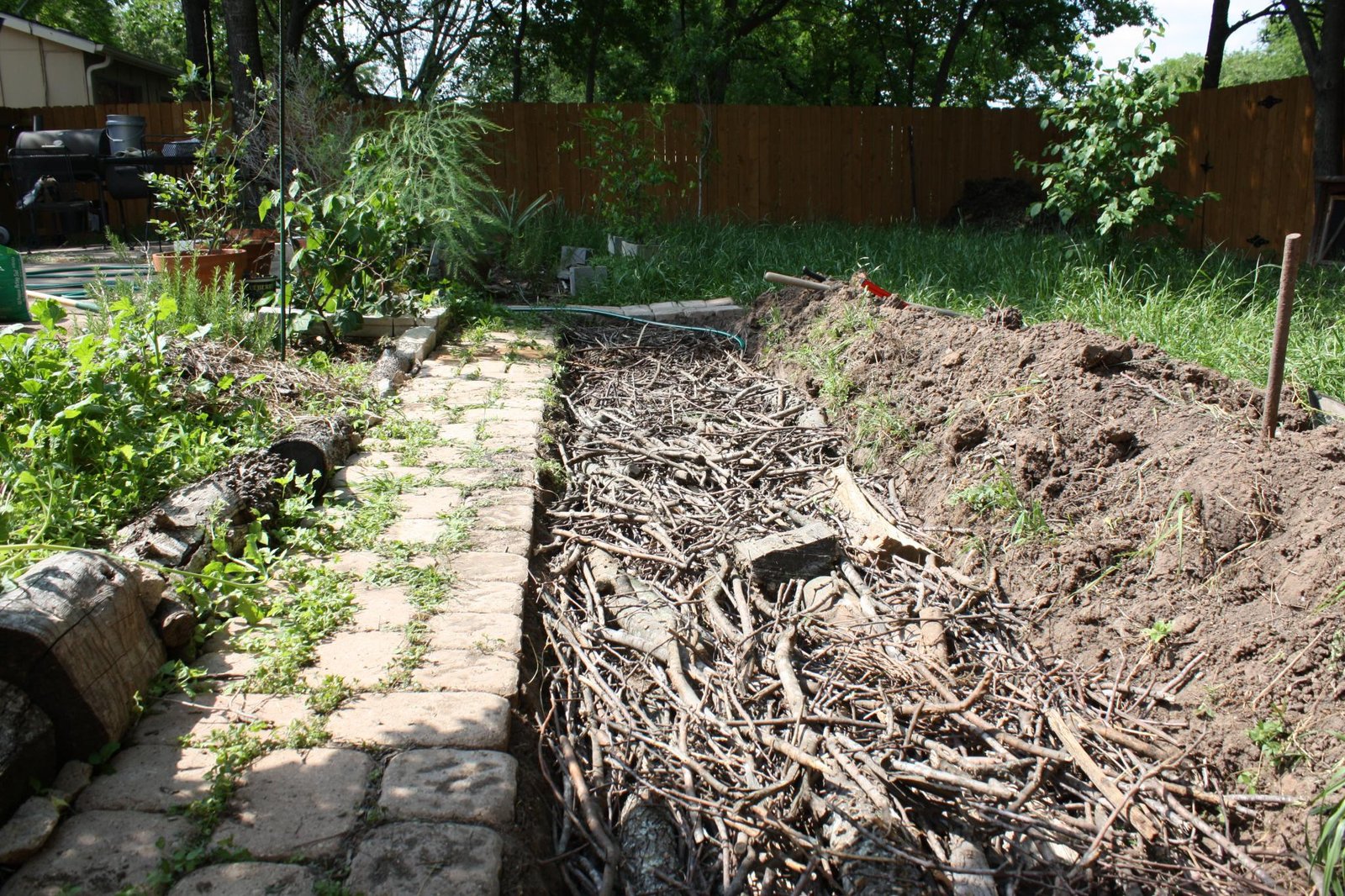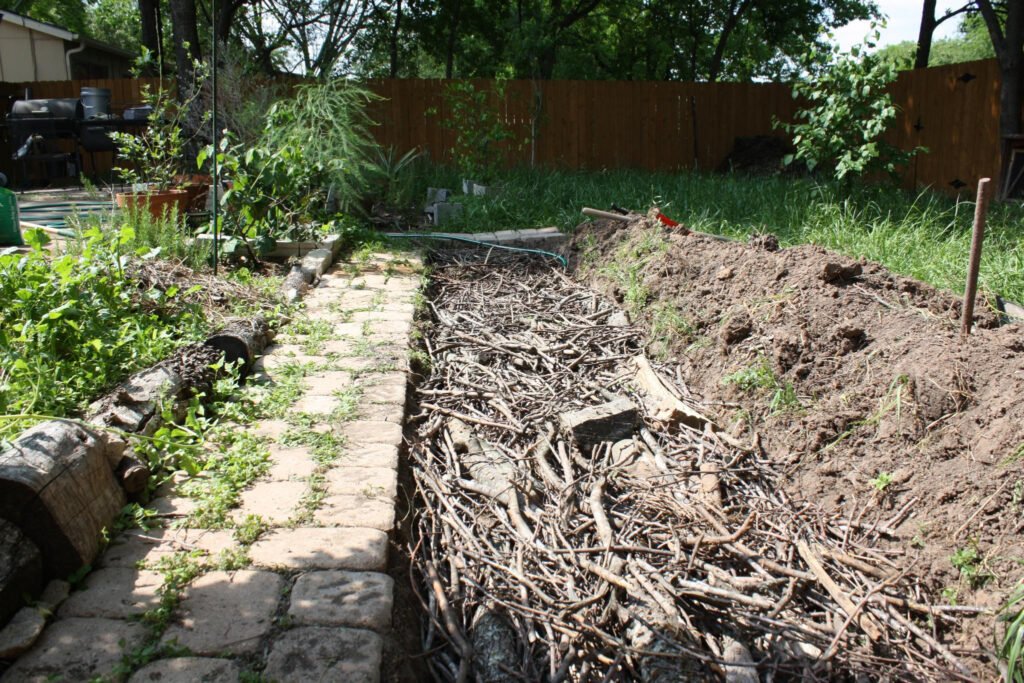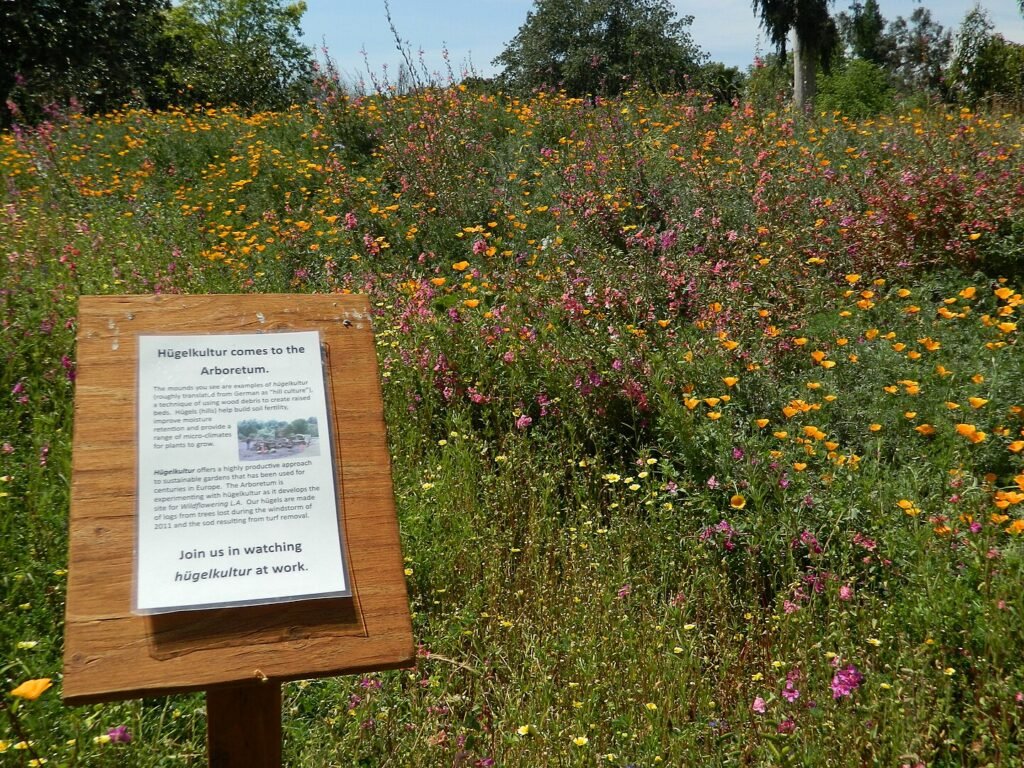Have you cut down trees or shrubs lately, but don’t know what to do with the leftover material? Build a hugelkultur bed! The hugelkultur method can be used to build beautiful raised beds, while preventing unnecessary garden waste. Read on to find out more!

Hugelkultur 101: Transforming Yard Waste into a Thriving Garden
What is Hugelkultur?

Hugelkultur is a gardening technique in which woody debris is piled into a mound and covered with soil to create a freeform raised bed. The term comes from Germany and Austria and means “mound culture” (it is also technically spelled hügelkultur, but less time typing umlauts means more time hugel-ing!) This technique is hundreds of years old but has regained prominence through the works of permaculturists like Sepp Holzer. Building hugelkultur beds is a great way to live out the permaculture principles of “produce no waste” and “catch and store energy”.
Benefits of Hugelkultur
Produce No Waste
Giving woody debris a second life in your garden is the number one benefit of building hugelkultur raised beds. If you send logs and branches to a landfill, you lose the biomass and nutrients embodied in that material. You also create additional pollution through the fossil fuels burned to transport those materials. Instead, a hugelkultur turns those “waste” products into tools for improving soil, capturing water, and creating beneficial microclimates in your garden.
Improve Soil
By burying logs, branches, and other woody debris, you add a tremendous amount of organic material back to the soil. This increases soil carbon content and provides material for beneficial fungi, microbes, worms, and other critters to feast on. As the mounded material breaks down, it creates loose, well aerated soil that is easier for plants to grow through. These benefits are of particular importance in compacted and depleted soils where plants would have otherwise struggled to get established. Remember, building a healthy ecosystem begins with building healthy soil!
Capture Water
Adding woody materials to the soil doesn’t just add nutrients, it turns the soil into a giant sponge! Decaying logs and branches are able to hold a tremendous amount of water. This water is then made available to plants growing into the mound. Additionally, the mounded shape of hugelkultur beds makes them ideal for intercepting water in the landscape. Mounds should be arranged on-contour (i.e. perpendicular to the slope). This slows the flow of surface water runoff, giving it more time to percolate into the soil. Thus, by organizing your raised beds correctly, you capture more water for your garden and help recharge groundwater in regions where it is depleted.
Create Microclimate
A further benefit of the mounded structure of hugelkultur beds is the microclimates they create. Any raised structure in a garden will create a sunnier side and a shadier side, a windward side and a leeward side. All of these factors create new niches for plants to grow in! Take advantage of these niches to shelter sensitive plants from the wind or to get sun loving plants some additional exposure! Additionally, similar to a compost pile, the breakdown of organic materials in the mound will create heat. This extra heat keeps hugels warmer than the surrounding areas, extending the growing season in the bed.
How to Build a Hugelkultur Bed

Pick a Site
Because hugelkultur forms a raised bed, many of its benefits can only be realized by placing the bed correctly within your site. Consider what additional benefits you are hoping to generate from your hugels.
Will it serve as a windbreak? If so, orient it perpendicular to the dominant wind direction to protect small plants behind it.
If you are seeking a sound barrier, place the hugelkultur raised bed between the source of noise and living spaces.
The most common and powerful benefit you can yield from hugelkultur is as a water sink. To do this, the raised bed should be arranged on-contour (or just off-contour, if being used to redirect water through the site). In doing this, the mound structure will intercept water flowing across the surface of the site, slowing it down and allowing it to seep into the ground.
Once you have selected a site and decided how the mound will be oriented, we recommend you stake out roughly where the edges of the mound will be to help with the next step.
Dig the Trench
The first layers of a hugelkultur bed are placed below the surface grade. The size of this trench will depend on how much woody material you have, what tools you have, and how large you want your final mound to be. Large-scale hugelkulturs in cleared forest areas can be up to 2 feet deep, 8 feet wide, and 150 feet long! However, it is unlikely that a home hugelkultur garden will be anywhere near this size.
Piling all of your woody material above ground before digging will give you a sense of the dimensions you will need for your trench. If you will be digging by hand, 9 inches to 18 inches deep and 3 to 5 feet wide make reasonable dimensions. If you are using an excavator and have sufficient wood debris, 18 to 24 inches deep and 5 to 8 feet wide makes sense.
When digging your trench, remember that the soil that you dig out will be used to backfill around your logs and branches and to cover the final mound. Make sure that your trench is large enough to provide soil for backfilling the mound. Pile soil on a tarp as you dig it out, so that it can be easily transferred back to the hugel.
There is no exact science to sizing the trench for a hugelkultur raised bed, so feel free to experiment and organize it in the way that makes the most sense for your site!
Build Layers
Once the trench is dug, you can begin layering in your materials. The largest logs and branches will form the base of your hugelkultur bed. Subsequent layers will use progressively smaller woody materials. After each layer is placed on the mound, backfill around the wood using soil dug from the trench. Each woody layer should be about a foot deep, and each soil layer should be around 6 inches deep. Keep an eye on how much soil you have remaining, as you will need to cover the mound at the end.
As you reach the final layers, consider including more nitrogenous materials, such as compost, grass clippings, or manure. These will enrich the topsoil of the hugelkultur bed and accelerate the breakdown of the woody materials. After the last layer has been placed, cover the mound with your remaining soil. Immediately after construction, you should water the mound extensively to help it settle into place. Walking or standing on the mound will also help this settling process.
Establish Plants

Last comes the ever important question: what do I plant in my hugelkultur bed? Plants from the herb, groundcover, vine, and root layers are all ideal candidates for hugelkultur gardening. These species will grow rapidly through the loosened soil and will not be stressed by the gradual settling that occurs as the woody materials break down.
Potatoes love hugelkultur! Thanks to the warming effects of the decomposing mound, potatoes can be started up to a month earlier in a hugel. Perennial pollinators, squash, and melons all thrive in hugelkultur beds as well.
Common Mistakes
Thinking You Need One!
The most common hugelkultur mistake is building one unnecessarily! Despite its benefits, hugelkultur gardening is just a tool in your toolbox. However, it is not always the best or only tool for the job! Remember, the number one reason to build a hugelkultur is because you have woody debris that needs to be used. If this debris is not available on site then you need to ship it in, burning fossil fuels and creating pollution. Instead, try to find other techniques to build soil with materials you have on site.
Incorrect Materials
Not all wood is created equal! If you are a woodworker or builder, you likely have scrap wood laying around. However, a lot of construction grade lumber has been pressure treated. This means that the wood has had chemicals forced into it that assist in fire-retardation and preservation. This is great for construction, but terrible for gardening! Pressure treated wood will be slow to break down and will release harmful chemicals into the soil. Stick to garden waste when building your hugelkultur raised bed!
Poor Placement
Remember that the decomposing biomass is only half the benefit of using the hugelkultur method! Be sure to observe your site thoroughly and follow the steps in the “Pick a Site” section above to maximize the placement of your hugelkultur bed. Also, remember that these mounds collect a lot of water. Therefore, they should not be placed in areas that already have chronically wet soil!
Incorrect Plants
It is a bad idea to plant trees in a hugelkultur bed. Although the rich soil and warm microclimate may seem ideal for all plants, the breakdown of materials in a hugelkultur causes the mound to settle over time. The settling process can compress roots or leave them exposed to air pockets. This will stress young trees, making them less hardy when planted in the berm of a hugelkultur. Instead, trees can be planted in the swales between hugelkultur mounds, where they can take advantage of the wind-breaking and water-trapping benefits that we have discussed above!
This article has talked about everything you need to know to start building and using hugelkultur raised beds! If you have any questions about hugelkultur, be sure to reach out to us; we would love to talk!

